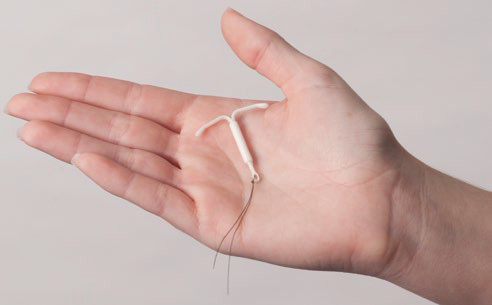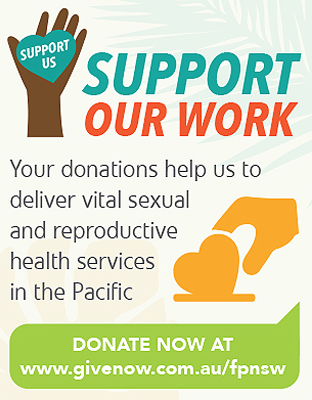Hormonal IUD
What is a hormonal IUD?
There are two types of hormonal intrauterine devices (IUDs) available in Australia. They are called Mirena© and Kyleena©. They are small plastic T-shaped devices with a hormone called levonorgestrel in their stem. Kyleena© is slightly smaller than Mirena© and contains a slightly lower amount of hormone. It's placed inside the uterus to prevent pregnancy. A fine nylon thread is attached to the IUD - the thread comes out through the cervix into the top end of the vagina. Both types of hormonal IUD last for 5 years.

How do they work?
The IUD is placed inside the uterus (womb) by a doctor or nurse. The hormonal IUD:
- stops sperm from fertilising the egg
- makes the mucus in the cervix thicker so that sperm can't get into the uterus
- changes the wall of the uterus, making it hard for an egg to attach to the wall
- sometimes stops your ovaries from releasing an egg
How well does it work?
Both types of hormonal IUD are very effective. The Mirena© hormonal IUD is 99.9% effective; the Kyleena© IUD is 99.7% effective.
Who can use a hormonal IUD?
A hormonal IUD is an option for people who:
- want a reliable, long-term contraceptive
- haven't had a pregnancy
- have decided to not have any more children
- would like to space out their pregnancies
- are breastfeeding
Both types can be used people with heavy periods but Mirena© is proven to be very effective at reducing bleeding during your period.
You should not use the hormonal IUD if:
- you might be pregnant
- you have a recent infection called pelvic inflammatory disease (PID)
- you have unusual bleeding from your vagina
- you have a history of breast cancer or some serious liver conditions
Talk to your doctor before deciding to use a hormonal IUD if you have:
- a recent sexually transmitted infection (STI)
- fibroids or other conditions that change the shape of your uterus
- previous problems with an IUD (for instance the IUD has come out by itself)
- you are unable to have a follow-up check-up after the IUD is put in
Advantages
- It's very effective
- It protects you against pregnancy for up to 5 years
- The initial cost of a hormonal IUD can be more than for other methods, but it lasts for 5 years
- Your fertility goes back to normal once the IUD is taken out
- Both types usually makes bleeding much lighter and sometimes periods stop all together (this is more likely with Mirena© than Kyleena©)
- It can reduce period pain
Disadvantages
- It doesn't protect against sexually transmitted infections(STIs)
- It requires a procedure to be put in and removed from the uterus; putting it in can be uncomfortable or painful for some people
- When the IUD is put in there is a small chance of:
- difficulty inserting the IUD
- damage to the wall of the uterus
- infection
- it can sometimes come out by itself
- You can have some irregular bleeding or spotting in the first few months
- You can get hormonal side effects like:
- bloating
- headaches
- mood changes
- acne
- lowered interest in sex
How do I get a hormonal IUD?
Only a specially trained doctor or nurse can put in an IUD. You may need to make two visits. A few things to consider about your IUD insertion include:
- the doctor or nurse will ask questions about your health
- you might have a vaginal examination, a cervical screening test or a test for infection
- you will be given a prescription for the hormonal IUD
- you need to get the hormonal IUD from a pharmacy before your next visit
- putting the IUD in takes about 10 minutes - although you will be at the clinic for about 1 hour
- you may find having the IUD put in a bit uncomfortable or painful and some people, and some people faint
- you can have a local anaesthetic
- some people have the IUD inserted under sedation - not all clinics provide this.
After your hormonal IUD is put in:
- you may have cramps and bleeding or spotting in the first few days. You can take paracetamol or ibuprofen or use a heat pack. See your doctor if cramps, spotting or pain last more than a few days
- avoid sex, tampons, swimming and baths for 2 days to reduce the risk of infection
- go back for a check-up if you have any concerns
- check the IUD threads each month to make sure the IUD is still in the right place. Your doctor or nurse will tell you how to do this
Remember, it is normal to have irregular bleeding and spotting in the first few months after the hormonal IUD is put in. Bleeding usually settles down and periods become shorter and lighter and may stop altogether.
Things to remember with your hormonal IUD:
- check the threads each month to make sure the IUD is in the right place
- see your doctor straight away if you have any unusual symptoms such as:
- discharge from your vagina
- pain low in your tummy
- deep pain during sex
- protect yourself from STIs by using a condom at the same time
- keep a record of the date to take out your IUD - it shouldn't stay in for longer than the recommended time
How is it taken out?
The hormonal IUD can stay in for 5 years but it can be taken out sooner. Your doctor or Family Planning NSW clinic can take it out. The clinician will remove the IUD by gently pulling on the string. This only takes a couple of minutes. Some people find it uncomfortable and some do not feel much at all. If you want another hormonal IUD, the old one can be taken out and a new one put in at the same visit.
For more information
Family Planning NSW Talkline - www.fpnsw.org.au/talkline or 1300 658 886
National Relay Service (for deaf people) - 13 36 77
TIS National's interpreting service - 131 450
Visit your nearest Family Planning NSW clinic - www.fpnsw.org.au/clinics
Family Planning NSW client resource on contraception - What suits me?


